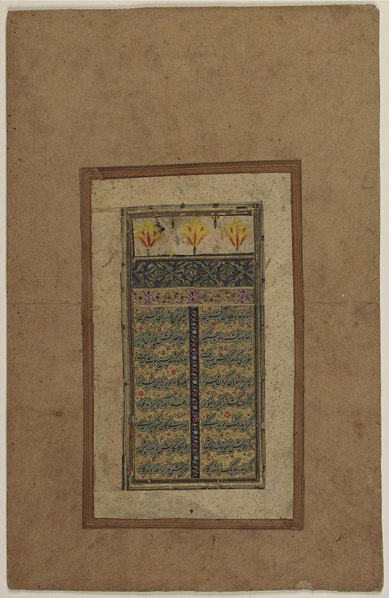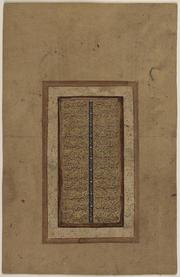File:First Page of Sa'di's "Bustan" WDL6850.pdf

Original file (1,329 × 2,045 pixels, file size: 1.72 MB, MIME type: application/pdf, 7 pages)
Captions
Captions
Summary edit
| Author |
Русский: Саади
Français : Sa'di
English: Sa'di
中文:萨迪
Português: Sa'di
العربية: سعدي
Español: Sa'di |
| Title |
Русский: Первая страница "Бустана" Саади
Français : Première page de « Boustan » de Sadi
English: First Page of Sa'di's "Bustan"
中文:出自萨迪《水果园》的首页
Português: Primeira página do “Bustan” de Sa'di
العربية: الصفحة الأولى من "بستان" السعدي
Español: Primera página de «Bostan», de Sa'di |
| Description |
Русский: Данный каллиграфический фрагмент состоит из первых семи страниц "Бустана" ("Фруктовый сад"), известной и популярной работы, написанной Шейхом Саади (умер в 1292 году / в 691 году хиджры) в 1256–1257 гг. В произведении содержатся истории, забавные случаи из жизни, басни и нравоучения. Эта копия "Бустана", возможно, была выполнена в Индии в XVII веке. На оборотной стороне второй страницы приводится довод в пользу этого предположения, поскольку в нем говорится, что данное произведение было написано Абд аль-Рашидом Дайлами, одним из известных каллиграфов, который работал при дворе императора Великих Моголов, Шах-Джахана (годы правления 1627–1656), в Агре и Дели. На первых шести страницах многократно восхваляется Аллах, что служит должным вступлением к тексту. На странице 7 приводится панегирик Пророку Мухаммеду. Как и в данном случае, первая страница персидского поэтического произведения легко узнаваема, так как вверху на ней изображена декоративная панель, главный текст заключен в декоративные полосы в виде облаков, а между текстом и интервалами, разделяющими стихи, расположены красочные орнаменты. На верхнем фризе изображено три желтых цветка, а также синяя горизонтальная полоса, украшенная орнаментом из золотых листьев и цветов.
Каллиграфия, персидская; Иллюминирование рукописей; Исламская каллиграфия; Исламские рукописи Français : Ce fragment de calligraphie est constitué des sept premières pages de Boustan (Le jardin des fruits), une œuvre célèbre et bien-aimée composée par Cheikh Sadi (mort en 691 après l'Hégire/1292 après J.-C.) en 1256–1257. L'œuvre contient des histoires, des anecdotes personnelles, des fables et une instruction morale. Cette copie de Boustan peut avoir été produite en Inde durant le XVIIe siècle. Le dos de la seconde page comprend une note soutenant cette provenance, car elle précise que l'œuvre a été rédigée par Abd al-Rashid Daylami, l'un des célèbres calligraphes actifs à la cour du souverain moghol Shah Jahan (règne : 1627-1656) à Agra et Delhi. Les six premières pages comprennent diverses louanges à Dieu en tant qu'incipit du texte. La page 7 est un éloge du prophète Mahomet. Dans ce document, la première page du texte poétique persan est facilement reconnaissable, car, outre son panneau d'ornementation en haut, le texte principal est habituellement décoré de motifs de bandes de nuages et d'enluminures décoratives entre le texte et dans l'espace séparant chaque verset de poésie. La frise supérieure contient trois fleurs jaunes ainsi qu'une bande horizontale bleue avec des motifs de fleurs et de feuilles dorées.
Calligraphie persane; Enluminures; Calligraphie islamique; Manuscrits islamiques English: This calligraphic fragment consists of the first seven pages of Bustan (The fruit garden), a famous and beloved work composed by Shaykh Sa'di (died 691 AH/1292) in 1256–57. The work contains histories, personal anecdotes, fables, and moral instruction. This copy of Bustan may have been produced in India during the 17th century. The back of the second page includes a note supporting this provenance, as it states that the work was written by 'Abd al-Rashid Daylami, one of the famous calligraphers active at the court of the Mughal ruler Shah Jahan (reigned 1627–56) in Agra and Delhi. The first six pages include various praises to God as an appropriate incipit to the text. Page 7 is an encomium to the Prophet Muhammad. As in this case, the first page of a Persian poetical text is easily recognizable, as it is provided with an ornamental panel at the top and the main text usually is decorated by cloud band motifs and decorative illumination between the text and in the gutter separating each verse of poetry. The top frieze contains three yellow flowers as well as a blue horizontal band decorated with a gold leaf and flower motifs.
Calligraphy, Persian; Illuminations; Islamic calligraphy; Islamic manuscripts 中文:这幅书法残卷包含 Bustan(《水果园》)的前七页,《水果园》是谢赫·萨迪(Shaykh Sa'di,卒于伊斯兰历 691 年/公元 1292 年)在 1256 年至 1257 年创作的著名而且深受爱戴的作品。这部作品包含历史故事、个人轶事、寓言和道德引导。该《水果园》副本可能是于 17 世纪在印度完成的。第二页的背面包含说明此残卷出处的注释,其中写道,这部作品由阿卜杜勒·拉希德·多乐美 ('Abd al-Rashid Daylami) 书写,他活跃于莫卧儿统治者沙贾汗(Shah Jahan,1627-1656 年在位)的宫廷,是阿格拉和德里著名的书法家之一。前六页包含各种真主赞美辞,作为正文的相应引言。第 7 页赞美了先知穆罕默德。在这部作品中,第一页的波斯语诗歌内容很容易辨认,因为它的的顶部设有装饰方框,正文通常装饰着带状云彩图案,文字内容之间以及在隔开每节诗歌的空白处均有装饰插图。顶部饰带中包含三朵黄色花朵,以及装饰有金色叶子和花卉图案的蓝色横向装饰帶。
书法,波斯语; 插图; 伊斯兰书法; 伊斯兰手稿 Português: Este fragmento caligráfico consiste nas sete primeiras páginas do Bustan (O jardim de frutas), uma obra famosa e adorada composta por Shaykh Sa'di (falecido em 691 a.H./1292) entre 1256 e 1257. A obra contém histórias, anedotas pessoais, fábulas e instrução moral. Esta cópia do Bustan pode ter sido produzida na Índia durante o século XVII. A parte de trás da segunda página inclui uma nota que favorece a tese da procedência indiana, já que afirma que a obra foi escrita por 'Abd al-Rashid Daylami, um dos famosos calígrafos em exercício na corte do governante mogol xá Jahan (reinou entre 1627 e 1656), em Agra e em Délhi. As seis primeiras páginas incluem vários louvores a Deus como um incipit apropriado ao texto. A página 7 é um encômio ao Profeta Maomé. Conforme ilustrado por este caso, a primeira página de um texto poético persa é facilmente reconhecível, já que ele é acompanhado de um painel ornamental no topo e o texto principal normalmente é decorado com motivos de mosaicos de nuvens e com iluminação decorativa entre o texto e o espaço separando cada verso da poesia. O friso superior contém três flores amarelas, bem como uma faixa horizontal azul decorada com uma folha dourada e motivos de flores.
Caligrafia, persa; Iluminuras; Caligrafia islâmica; Manuscritos islâmicos العربية: تتألف هذه القطعة الخطيّة من الصفحات السبعة الأولى من البستان، وهو عمل شهير وأثير ألفه في 1256- 1257 الشيخ السعدي (تُوفي 691 هـ/1292). يحتوي العمل على مؤلفات تاريخية ونوادر شخصية وحكايات ودروس أخلاقية. قد تكون هذه النسخة من البستان أُنتِجَت في الهند أثناء القرن السابع عشر. يحتوي الجزء الخلفي من الصفحة الثانية على ملاحظة تؤكد صحة هذا المنشأ، حيث تنص على أن العمل كتبه عبد الرشيد ديلمي، أحد الخطّاطين المشهورين الذين نشطوا في بلاط الحاكم المغولي شاه جهان (حكم ما بين 1627-1656) في أغرا ودلهي. تتضمن الصفحات الستة الأولى الثناء على الله في مواضع عدة مثلما جرت العادة في افتتاحيات النصوص. أما الصفحة السابعة فهي مدحٌ للرسول محمد صلى الله عليه وسلم. في هذه الحالة أيضاً، يمكن التعرف علي الصفحة الأولى من هذا النص الشعريّ الفارسي بسهولة، حيث تكون مزودة بلوحة زخرفية في الأعلى ويُزيّن النص الأصلي عادةً بشرائط من السحاب وزخارف بين النص وفي المساحة الفاصلة بين كل بيت من أبيات القصيدة. يحتوي الإفريز العلوي على ثلاث زهور صفراء بالإضافة إلى شريط أزرق أفقي مزين بورقة ذهبية وأشكال زهور.
الخط، الفارسي; الزخارف; الخط الإسلامي; المخطوطات الإسلامية Español: Este fragmento caligráfico consta de las siete primeras páginas de Bostan (El jardín de las frutas), una famosa y querida obra compuesta por el jeque Sa'di (fallecido en 691 d. H./1292 d. C.) en 1256-1257 d. C. La obra tiene historias, anécdotas personales, fábulas y enseñanzas morales. Es posible que esta copia de Bostan se haya producido en India en el siglo XVII. La parte posterior de la segunda página incluye una nota que confirma esta procedencia, ya que afirma que la obra fue escrita por 'Abd al-Rashid Daylami, uno de los famosos calígrafos en actividad en la corte del gobernante mogol Shah Jahan (que reinó entre 1627 y 1656) en Agra y Delhi. Las seis primeras páginas incluyen diversas alabanzas a Dios como un íncipit apropiado para el texto. La página 7 es un encomio al profeta Mahoma. Como en este caso, la primera página de un texto poético persa es fácil de reconocer, ya que tiene un panel ornamental en la parte superior, y el texto principal suele estar decorado con motivos de bandas de nubes y con iluminación decorativa entre el texto y en el canal que separa cada verso de la poesía. El friso superior tiene tres flores amarillas, así como una tira horizontal azul adornada con dorado a la hoja y motivos florales.
Caligrafía, persa; Iluminaciones; Caligrafía islámica; Manuscritos islámicos |
| Date |
between 1600 and 1699 date QS:P571,+1650-00-00T00:00:00Z/7,P1319,+1600-00-00T00:00:00Z/9,P1326,+1699-00-00T00:00:00Z/9 |
| Medium |
Русский: Рукописи
Français : Manuscrits
English: Manuscripts
中文:手稿
Português: Manuscritos
العربية: مخطوطات
Español: Manuscritos |
| Dimensions |
English: 21.1 x 33.4 centimeters |
| Collection |
Русский: Библиотека Конгресса
Français : Bibliothèque du Congrès
English: Library of Congress
中文:国会图书馆
Português: Biblioteca do Congresso
العربية: مكتبة الكونغرس
Español: Biblioteca del Congreso |
| Current location |
Русский: Избранные произведения арабской, персидской и османской каллиграфии
Français : Sélections de calligraphies arabes, persanes et ottomanes
English: Selections of Arabic, Persian and Ottoman Calligraphy
中文:阿拉伯、波斯和奥斯曼书法选集
Português: Seleções da caligrafia árabe, persa e otomana
العربية: مختارات من الخطوط اليدوية العربية و الفارسية والعثمانية
Español: Selecciones de caligrafía árabe, persa y otomana |
| Place of creation |
Русский: Индия
Français : Inde
English: India
中文:印度
Português: Índia
العربية: الهند
Español: India |
| References | http://hdl.loc.gov/loc.wdl/dlc.6850 |
| Source/Photographer |
http://dl.wdl.org/6850/service/6850.pdf
|
Licensing edit
|
This is a faithful photographic reproduction of a two-dimensional, public domain work of art. The work of art itself is in the public domain for the following reason:
The official position taken by the Wikimedia Foundation is that "faithful reproductions of two-dimensional public domain works of art are public domain".
This photographic reproduction is therefore also considered to be in the public domain in the United States. In other jurisdictions, re-use of this content may be restricted; see Reuse of PD-Art photographs for details. | |||||
File history
Click on a date/time to view the file as it appeared at that time.
| Date/Time | Thumbnail | Dimensions | User | Comment | |
|---|---|---|---|---|---|
| current | 06:56, 14 March 2014 |  | 1,329 × 2,045, 7 pages (1.72 MB) | Fæ (talk | contribs) | =={{int:filedesc}}== {{Artwork |artist = |author ={{ru|1=Саади}} {{fr|1=Sa'di}} {{en|1=Sa'di}} {{zh|1=萨迪}} {{pt|1=Sa'di}} {{ar|1=سعدي}} {{es|1=Sa'di}} |title ={{ru|1=Первая страница "Бустана"... |
You cannot overwrite this file.
File usage on Commons
The following page uses this file:
Metadata
This file contains additional information such as Exif metadata which may have been added by the digital camera, scanner, or software program used to create or digitize it. If the file has been modified from its original state, some details such as the timestamp may not fully reflect those of the original file. The timestamp is only as accurate as the clock in the camera, and it may be completely wrong.
| Image title |
|
|---|---|
| File change date and time | 07:02, 12 December 2013 |
| Date and time of digitizing | 07:00, 12 December 2013 |
| Date metadata was last modified | 07:02, 12 December 2013 |
| Software used | Adobe Acrobat 9.4.3 |
| Keywords |
|
| Conversion program | Adobe Acrobat 9.4.3 Image Conversion Plug-in |
| Encrypted | no |
| Page size |
|
| Version of PDF format | 1.6 |
